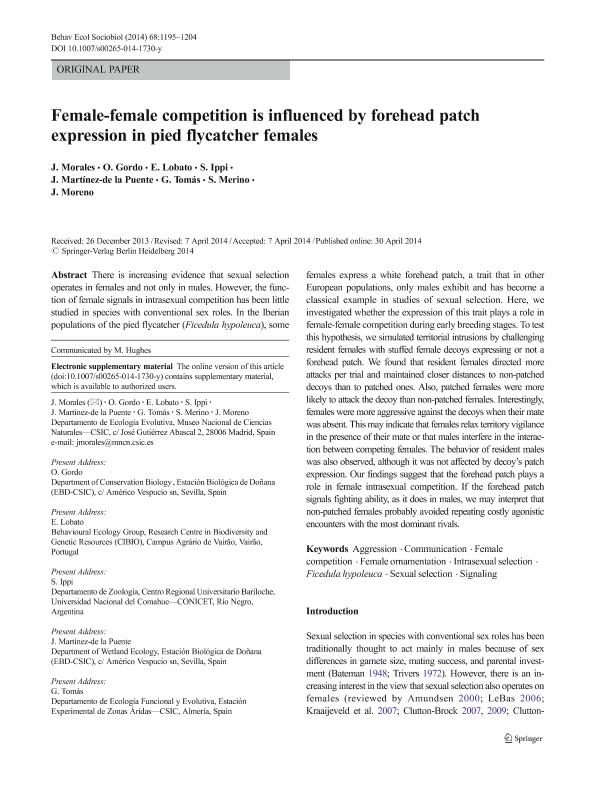Artículo
Female-female competition is influenced by forehead patch expression in pied flycatcher females
Morales, J.; Gordo, O.; Lobato, E.; Ippi, Silvina Graciela ; Martínez de la Puente, J.; Tomás, G.; Merino, S.; Moreno, J.
; Martínez de la Puente, J.; Tomás, G.; Merino, S.; Moreno, J.
 ; Martínez de la Puente, J.; Tomás, G.; Merino, S.; Moreno, J.
; Martínez de la Puente, J.; Tomás, G.; Merino, S.; Moreno, J.
Fecha de publicación:
06/2014
Editorial:
Springer
Revista:
Behavioral Ecology And Sociobiology
ISSN:
0340-5443
Idioma:
Inglés
Tipo de recurso:
Artículo publicado
Clasificación temática:
Resumen
There is increasing evidence that sexual selection operates in females and not only in males. However, the function of female signals in intrasexual competition has been little studied in species with conventional sex roles. In the Iberian populations of the pied flycatcher (Ficedula hypoleuca), some females express a white forehead patch, a trait that in other European populations, only males exhibit and has become a classical example in studies of sexual selection. Here, we investigated whether the expression of this trait plays a role in female-female competition during early breeding stages. To test this hypothesis, we simulated territorial intrusions by challenging resident females with stuffed female decoys expressing or not a forehead patch. We found that resident females directed more attacks per trial and maintained closer distances to non-patched decoys than to patched ones. Also, patched females were more likely to attack the decoy than non-patched females. Interestingly, females were more aggressive against the decoys when their mate was absent. This may indicate that females relax territory vigilance in the presence of their mate or that males interfere in the interaction between competing females. The behavior of resident males was also observed, although it was not affected by decoy's patch expression. Our findings suggest that the forehead patch plays a role in female intrasexual competition. If the forehead patch signals fighting ability, as it does in males, we may interpret that non-patched females probably avoided repeating costly agonistic encounters with the most dominant rivals.
Archivos asociados
Licencia
Identificadores
Colecciones
Articulos(CCT - PATAGONIA NORTE)
Articulos de CTRO.CIENTIFICO TECNOL.CONICET - PATAGONIA NORTE
Articulos de CTRO.CIENTIFICO TECNOL.CONICET - PATAGONIA NORTE
Citación
Morales, J.; Gordo, O.; Lobato, E.; Ippi, Silvina Graciela; Martínez de la Puente, J.; et al.; Female-female competition is influenced by forehead patch expression in pied flycatcher females; Springer; Behavioral Ecology And Sociobiology; 68; 7; 6-2014; 1195-1204
Compartir
Altmétricas
Items relacionados
Mostrando titulos relacionados por título, autor y tema.
-
Tavalieri, Yamil Ezequiel; Galoppo, Germán Hugo; Canesini, Guillermina ; Truter, J.C.; Ramos, Jorge Guillermo ; Luque, Enrique Hugo ; Muñoz de Toro, Monica Milagros (Academic Press Inc Elsevier Science, 2019-03)
-
Torrano, María Andrea (Instituto Latinoamericano de Estudios Críticos Animales, 2020-06)



